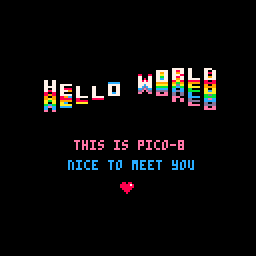While you wait: PICO-8
While waiting for the next entries and until I learn how to edit the first video, appreciate this masterpiece:
The PICO-8 is a tiny “fantasy console” for games that lets you have fun programming cute 8-bit games and tunes, but without messing about with real hardware and archaic programming languages.
You can write demos, games and gimmicks for the PICO-8 console in Lua, for example:
t = 0
music(0) -- play music from pattern 0
function _draw()
cls()
for i=1,11 do -- for each letter
for j=0,7 do -- for each rainbow trail part
t1 = t + i*4 - j*2 -- adjusted time
y = 45-j + cos(t1/50)*5 -- vertical position
pal(7, 14-j) -- remap colour from white
spr(16+i, 8+i*8, y) -- draw letter sprite
end
end
print("this is pico-8", 37, 70, 14)
print("nice to meet you", 34, 80, 12)
spr(1, 64-4, 90) -- draw heart sprite
t += 1
end
gives us (in conjunction with a sprite file, i.e. ready-to-put graphics, in this case the inscription HELLO WORLD with a heart) the effect visible on the nearby GIF.
Interestingly, the console has a built-in code editor, and I load games and demos with my familiar commands: LOAD filename.p8 and RUN. Like on the C64, Amstrad, Spectrum, Atari … you get the idea.
The while project is cute, and requires developers to be able to express themselves in 128 pixels of width and height, in 16 colors, and a maximum of 32 kilobytes.
The music you experienced if you clicked the button at the top of the post, along with the player (visualization) is therefore a remake, not just an execution of the original Amstrad code, or at least it has to be a Lua-coded player of music files containing instructions for the AY3 processor (the chip used in Amstrad, Atari ST, MSX, ZX Spectrum, TRS-80 and others; Commodore 64 used a different chip to generate sound). The songs themselves come from the games with the given names. Don’t forget to try to switch between them with the left and right arrows.
The PICO-8 is of course a completely contemporary project, and the hardware it “emulates” never physically existed. Even so, I am fascinated by the multitude of creations for this platform.


